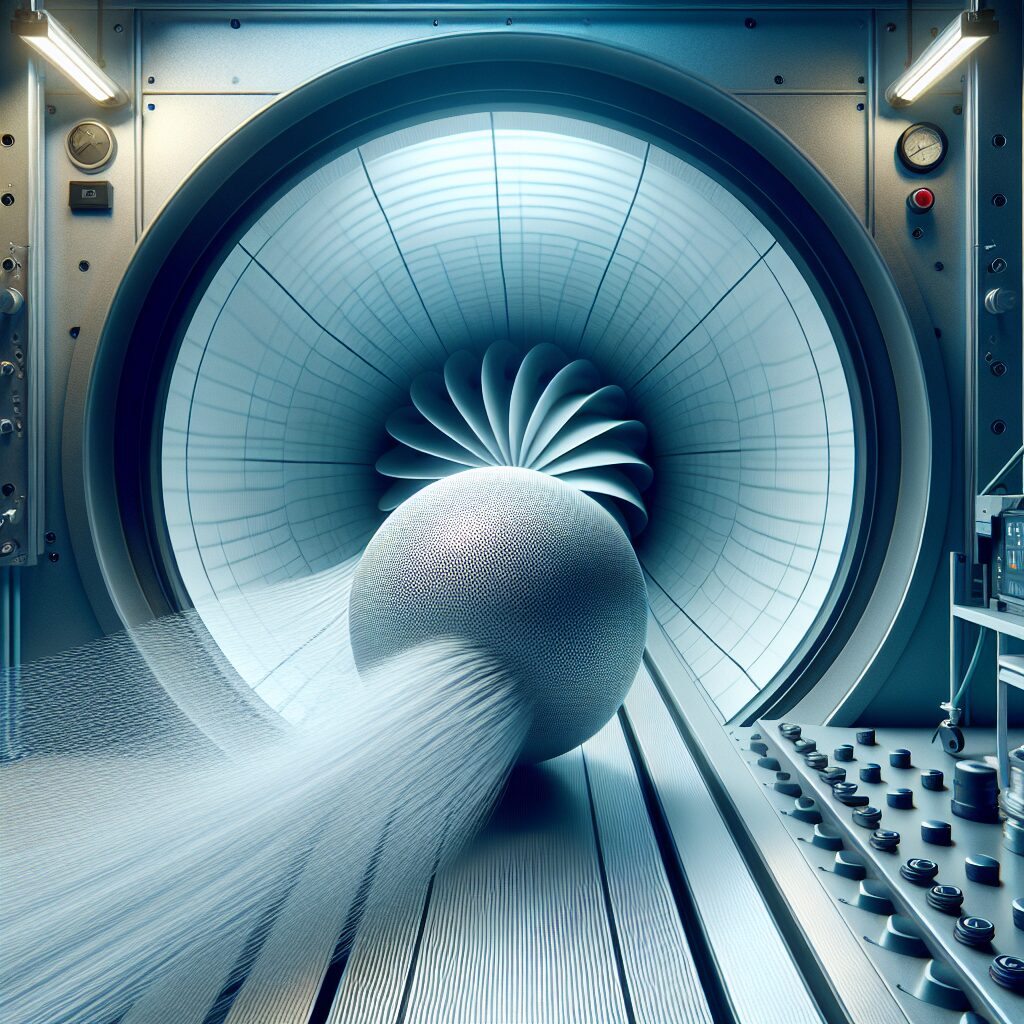Wind Tunnel Technology: Exploring Ball Aerodynamics
Did you know that the trajectory of a ball in flight is not solely determined by the force applied to it? The aerodynamics of the ball has a significant impact on its path and stability. This is where wind tunnel technology comes into play. Wind tunnel technology is a scientific technique used to study the flow of air around objects, such as balls, to better understand their aerodynamic properties.
When it comes to ball aerodynamics, wind tunnel technology allows researchers to analyze the forces acting on a ball as it moves through the air. By subjecting the ball to controlled wind conditions, scientists can measure parameters like drag, lift, and side forces. These factors influence the ball’s stability, control, and the amount of air resistance it experiences. By studying the effects of different variables, such as ball design and surface texture, wind tunnel testing helps optimize ball performance, ensuring they meet the demands of various sports.
Now that we have a grasp on the significance of wind tunnel technology in understanding ball aerodynamics, let’s delve into the key takeaways of this powerful tool. In the next section, we will explore how wind tunnel testing has revolutionized ball design, allowing manufacturers to enhance performance and optimize player experience. Additionally, we will discuss the impact of wind tunnel research on sports equipment regulations, ensuring fair play and safety. Get ready to unravel the secrets hidden within the invisible currents of the air!
Key Takeaways
1. Wind tunnel technology is crucial for studying the aerodynamics of balls, helping researchers understand the complex forces acting on them during flight.
2. The shape and surface of a ball play a significant role in its overall aerodynamic behavior, with dimples reducing resistance and creating lift, improving stability and distance traveled.
3. Wind tunnel testing offers precise measurement and collection of data on a ball’s behavior, including drag, lift, and spin, enabling researchers to optimize design for different sporting applications.
4. Understanding the aerodynamics of balls is fundamental for improving performance and accuracy in various sports, such as golf, football, and tennis, providing athletes and manufacturers with valuable insights for enhancing their equipment.
5. The future of wind tunnel technology holds potential for even more advanced testing methodologies, combining computational fluid dynamics and wind tunnel experiments to facilitate further progress in ball aerodynamics research.
Can Wind Tunnel Technology Help Us Explore Ball Aerodynamics?
The Significance of Wind Tunnel Technology in Studying Ball Aerodynamics
Wind tunnel technology has revolutionized the way we understand ball aerodynamics. By simulating different air conditions in controlled environments, wind tunnel testing provides invaluable insights into the behavior of various types of balls. These insights play a crucial role in improving the performance of sports equipment and optimizing game strategies.
The Basics of a Wind Tunnel
A wind tunnel is a specialized facility designed to study the interaction between solid objects, such as balls, and the air that surrounds them. It consists of a test section, where the object is placed, and a powerful fan or compressor that generates controlled airflow within the tunnel. By adjusting parameters like airspeed, pressure, and temperature, researchers can replicate real-life conditions and observe the impact on ball aerodynamics.
Key Components of Wind Tunnel Technology
In order to accurately analyze ball aerodynamics, wind tunnels are equipped with several crucial components:
1. Test Section
The test section is where the ball is placed for experimentation. It is designed to minimize air disturbances and ensure that the airflow around the ball remains consistent. The dimensions and shape of the test section can vary depending on the specific research requirements.
2. Wind Tunnel Model
To accurately replicate ball aerodynamics, researchers often use scaled-down models of the real ball in wind tunnel testing. These models are meticulously crafted to mimic the exact shape and surface characteristics of the ball being studied. By using these models, researchers can obtain precise data without the challenges associated with full-scale testing.
3. Instrumentation
Instrumentation is a crucial part of wind tunnel testing. Sensors and measurement devices are strategically placed around the test section to gather data on various parameters, including drag, lift, and boundary layer characteristics. Advanced measurement techniques, such as pressure taps and high-speed cameras, provide researchers with detailed insights into the complex interactions between the ball and the surrounding air.
Applications of Wind Tunnel Technology in Ball Aerodynamics
Wind tunnel technology finds applications in a wide range of domains where ball aerodynamics is a critical factor. Let’s explore some key areas where wind tunnel testing has proved to be invaluable:
1. Sports Equipment Design
Wind tunnel experiments allow sports equipment manufacturers to optimize the design of balls used in different sports. By analyzing the aerodynamic forces acting on the ball, engineers can fine-tune factors like surface texture, weight distribution, and shape to enhance performance. Wind tunnel testing has been instrumental in developing balls that exhibit better stability, accuracy, and control.
2. Performance Analysis
Wind tunnel technology enables coaches and athletes to analyze the performance of different balls under various conditions. By testing the impact of changing environmental factors, such as wind speed and temperature, on ball trajectories, they can better understand how to adapt their game strategies. This knowledge helps in maximizing performance and gaining a competitive edge.
3. Safety and Regulations
Wind tunnel testing plays a vital role in ensuring the safety and compliance of balls used in sports. By analyzing the aerodynamic properties of balls, regulatory bodies can enforce standards that minimize risks associated with unpredictable flight patterns or excessive drag. This helps maintain fairness and protect players from potential harm.
Conclusion: Harnessing Wind Tunnel Technology for Better Ball Aerodynamics
Wind tunnel technology provides a powerful platform for exploring the intricate relationship between balls and the air they move through. By utilizing sophisticated instrumentation and precise testing methodologies, researchers can unlock valuable insights that drive innovation in sports equipment design, enhance performance analysis, and ensure safety and compliance. As technology continues to advance, wind tunnel testing will undoubtedly play a pivotal role in shaping the future of ball aerodynamics.
Can’t get enough of Wind Tunnel Technology: Exploring Ball Aerodynamics? Here are some tips to dive deeper:
1. Familiarize yourself with different wind tunnel models available in the market and their capabilities. Understanding the strengths and limitations of each model will allow you to make informed choices for your research.
2. Stay up to date with the latest advancements in wind tunnel technology. Regularly review scientific literature and attend conferences or seminars focused on aerodynamics and ball physics.
3. Consider collaborating with experts in the field who have extensive experience in wind tunnel testing. Their insights and guidance can significantly enhance the quality and reliability of your research.
4. Experiment with different ball configurations during wind tunnel testing. Analyze the effects of surface roughness, dimple patterns, or material composition on ball aerodynamics to gain a deeper understanding of their impact on performance.
5. Take advantage of computational fluid dynamics (CFD) simulations in conjunction with wind tunnel testing. CFD allows you to virtually simulate and analyze ball aerodynamics, providing additional insights and reducing the need for extensive physical testing.
Frequently Asked Questions
1. How does wind tunnel technology help in exploring ball aerodynamics?
Wind tunnel technology allows researchers to study and analyze the behavior of balls in controlled environments by precisely manipulating air speed, pressure, and direction. This helps in understanding how different factors affect ball aerodynamics and can lead to improvements in sports equipment design, performance, and tactics.
2. What are the key parameters measured in wind tunnel experiments?
In wind tunnel experiments for ball aerodynamics, key parameters such as drag, lift, and Magnus force are typically measured. Drag is the resistance experienced by the ball as it moves through the air, while lift is the force perpendicular to the direction of motion that affects how the ball stays in the air. The Magnus force is the resulting side force caused by the spin of the ball.
3. How does the shape of a ball affect its aerodynamics?
The shape of a ball plays a crucial role in its aerodynamics. Different ball shapes create varying levels of drag and lift, which in turn affect their flight characteristics. For example, a smooth spherical ball will generally have lower drag than a ball with rough or uneven surfaces.
4. Can wind tunnel testing help in developing more accurate sports equipment?
Yes, wind tunnel testing is instrumental in developing more accurate sports equipment. By analyzing the aerodynamic properties of different ball designs and materials, manufacturers can optimize the performance of sports balls such as footballs, golf balls, and tennis balls. This can lead to better control, trajectory, and accuracy for athletes.
5. How do different environmental conditions affect ball aerodynamics?
Different environmental conditions, such as temperature, humidity, altitude, and wind speed, can significantly impact ball aerodynamics. For instance, higher temperatures can decrease air density and influence the behavior of the ball, while wind speed and direction can cause variations in drag and ball flight.
6. Can wind tunnel testing be used to study the aerodynamics of non-spherical balls?
Yes, wind tunnel testing can be applied to study the aerodynamics of non-spherical balls as well. By analyzing their drag, lift, and spin characteristics, researchers can gain insights into how these irregularly shaped balls behave in various sports and recreational activities.
7. What role does spin play in ball aerodynamics?
Spin plays a significant role in ball aerodynamics. When a ball is spinning, it experiences the Magnus effect, where the airflow around the spinning ball creates a pressure difference and results in a side force. This force can cause the ball to curve or deviate from its expected trajectory.
8. How are wind tunnel experiments for ball aerodynamics conducted?
Wind tunnel experiments for ball aerodynamics involve placing the ball inside a wind tunnel, where the airspeed, pressure, and other parameters can be precisely controlled. The ball is then subjected to various conditions and forces, while sensors and cameras capture data and analyze the ball’s behavior.
9. Are wind tunnel experiments the only method used to study ball aerodynamics?
No, wind tunnel experiments are just one of the methods used to study ball aerodynamics. Other techniques, such as computer simulations, mathematical modeling, and field tests, also contribute to our understanding of how balls interact with the air and how their aerodynamics can be optimized.
10. How can the findings from wind tunnel experiments benefit athletes?
The findings from wind tunnel experiments can benefit athletes by providing valuable insights into the aerodynamics of balls used in their respective sports. This knowledge can help athletes make informed decisions about their equipment, technique, and strategy, ultimately enhancing their performance and competitive edge.
Final Thoughts on Wind Tunnel Technology: Exploring Ball Aerodynamics
Understanding the intricate relationship between balls and the air they move through is crucial in various sports and recreational activities. Wind tunnel technology offers a powerful tool for unraveling the complexities of ball aerodynamics, enabling researchers and manufacturers to push the boundaries of performance and innovation. By continuously exploring and refining ball aerodynamics, we can expect advancements in sports equipment design, more exciting gameplay, and enhanced athletic achievements.
Whether it’s the swerve of a soccer ball, the controlled flight of a golf ball, or the accuracy of a tennis serve, the principles of wind tunnel technology allow us to delve deeper into the science behind these actions. As technology continues to advance, we can anticipate even more precise and detailed investigations into the aerodynamics of balls, leading to new strategies, techniques, and records in the world of sports.




